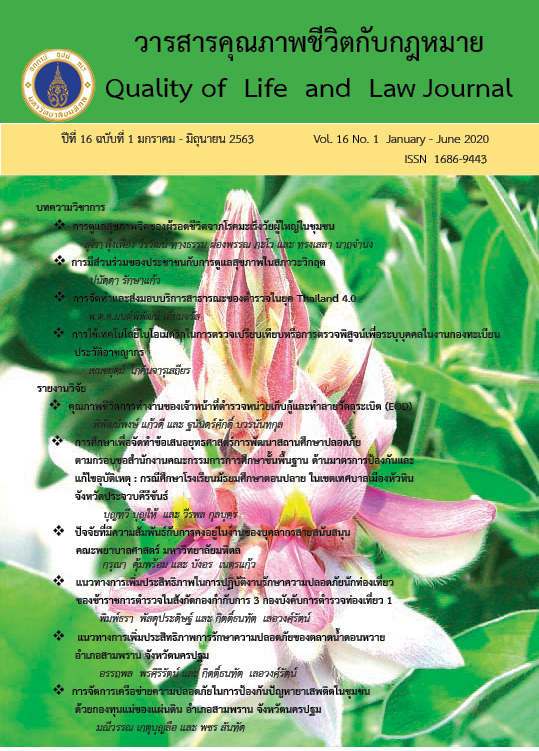The use of biometrics technology for inspection, comparison, or verification to prove the person in Criminal Records Division
Main Article Content
Abstract
At present, the technology used for comparison or verification In order to identify individuals, there are many technologies, Biometric technology is another technology that is developing rapidly. Biometric technology is widely applied to both the public and private sectors. Due to the use of Biometric technology for comparison or verification To identify people with biometric data, very accurate and very reliable because it is highly unique and difficult to imitate. In this article, the author presents an overview of the use of Biometric technology. In comparison or testing to identify individuals. By using biometric data that is biological and behavioral data. As well as presenting the characteristics Roles, duties, and importance of criminal record registration work National Police Agency That Criminal Records Division is important to the investigation And how to prevent and suppress crime In order to see the importance that has led to the introduction of Biometric technology Developed to be used to identify persons of Criminal Records Division by using biometric technology to help compare the biometric data of the suspect and the biometric data that Criminal Records Division is stored in the database, to be a tool to identify offenders and make investigations Criminal investigations become even more reliable.
Article Details
- บทความหรือข้อคิดเห็นใดๆ ในวารสารคุณภาพชีวิตกับกฎหมายเป็
- กองบรรณาธิการไม่สงวนสิทธิ์
References
พิชัย อำนวยกาญจนสิน. (2558). “การตรวจหาและติดตามใบหน้าด้วยกล้องวีดีทัศน์ 2 ตัวแบบส่ายก้มเงย.” วิทยานิพนธ์วิศวกรรมศาสตรมหาบัณฑิต สาขาวิศวกรรมไฟฟ้า บัณฑิตวิทยาลัย จุฬาลงกรณ์มหาวิทยาลัย.
พัชรา สินลอยมา. (2548). การทะเบียนประวัติอาชญากรและการพิมพ์ลายนิ้วมือ. กรุงเทพฯ: โรงพิมพ์พิทักษ์อักษร.
ยงยุธ สารวงษ์. (2550). “การรู้จำใบหน้าโดยใช้ตัวแบบเซลลูลาร์ออโตมาตา.” วิทยานิพนธ์วิทยาศาสตร์มหาบัณฑิต สาขาเทคโนโลยีสารสนเทศ บัณฑิตวิทยาลัย มหาวิทยาลัยเทคโนโลยีพระจอมเกล้าพระนครเหนือ.
อัจฉริยา อักษรอินทร์. (2560). ไบโอเมตริก : มาตราวัด “คุณ”แห่งอนาคต. กรุงเทพฯ: NECTEC.
Afsar FA, Arif M, Hussain M. Fingerprint Identification and Verification System using Minutiae Matching. 2008.
Bauer and Mazurkiewicz .2015. “Neural Network and Optical Correlators for Infrared Imaging Based Face Recognition.” In Proceedings of the 5th International Conference on Intelligent Systems Design and Applications (ISDA’05), pp.234-238. Wroclaw: IEEE Computer Society.
Delac, K., and Grgic, M. (2004).“A Survey of Biometric Recognition Methods.” In Proceedings of the 46th International Symposium on Electronics in Marine, pp.184-193. Zadar:IEEE.
Ferrer MA, (2016). “Hand geometry identification system performance.”Security Technology, 2016 43rd Annual 2016 International Carnahan Conference on; Oct 5-8.
Maiorana E. (2008). “Cancelable Biometrics for HMM-based Signature Recognition. Biometrics: Theory”, Applications and Systems, 2014 BTAS 2014 2nd IEEE International Conference on; Oct 1.
Victor, Bowyer, and Sarkar. (2016) “An Evaluation of Face and Ear Biometrics.” In Proceedings of the International Conference on Pattern Recognition, pp. 429-432. Quebec: IEEE Computer Society.
Hartjen,Clayton A, “Crime and Criminalization.” 2th ed.,New York : Robert E. Kriger Publishing Co.,1978,p.3.
Sutherland, Edwin H and Cressey, “Principle of Criminology.” 6th ed.,Philadelphia : J.E. Lippincott Co.,1968, p.4.


